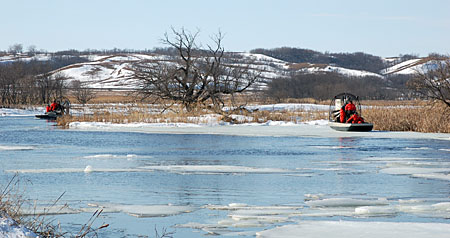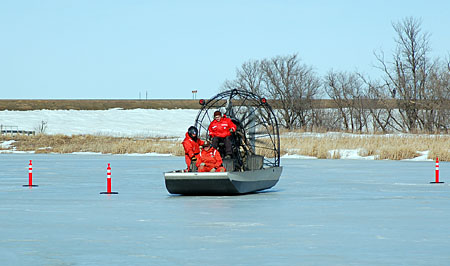Kenmare ND - Features
Real People. Real Jobs. Real Adventures.
Thanks for reading some of the latest features about area people and events.
To view every page and read every word of The Kenmare News each week,
subscribe to our ONLINE EDITION!
Airboats on ice
The usually quiet winter afternoons at the spillway on the Upper Souris National Wildlife Refuge where ice fishermen gather to try their luck were noisy last week with four airboats running up and down the Mouse River on the other side.
2/23/11 (Wed)
The usually quiet winter afternoons at the spillway on the Upper Souris National Wildlife Refuge where ice fishermen gather to try their luck were noisy last week with four airboats running up and down the
U.S. Fish & Wildlife Service personnel, along with North Dakota Game & Fish Department employees, were learning how to operate their airboats on ice--as well as gravel, cattails, mud, asphalt, snowdrifts and every possible combination of those elements.
The lessons may have looked like fun, with snow sprays and spinning boats at times, but the intent was serious preparation for the 2011 flooding season in the
Tighe Teets, refuge officer for the Souris Basin Complex which includes the
According to
Teets, who has run airboats since 1996 for refuge operations and emergency responses like hurricanes and floods in the southern
The Upper Souris NWR proved to be an ideal location, with open water, solid ice, ice floes, snow drifts, bare ground, gravel and asphalt all available in a central location. Class members met at refuge headquarters for discussions about cold water safety and survival techniques, law enforcement concerns, radio communications, and boat maintenance in winter conditions, but changed into their cold weather survival/flotation suits to operate the boats for the afternoon.
Teets and the other instructors put the trainees through their paces, beginning with simply getting the boats safely off the trailers in icy conditions. The operators practiced driving their boats across snowdrifts onto solid ice, across roads and through ditches, and over the tops of floating slabs of ice, simulating conditions they could face during spring flooding in the Red River or
“The only place these boats can’t go is through the trees,” Teets said, even as operators sent their boats up a levee or the riverbank.
Two areas were set up with cones on solid ice to simulate obstacles commonly found in a flooded neighborhood, such as mailboxes, parked cars, street signs and rows of sandbags. The operators were required to navigate their airboats, without the benefit of a reverse gear, safely through the cones.
“This is such a bizarre concept,” Teets said. He had to caution the operators about changing conditions of snow and ice because of melting throughout the day and talk about ways to free an airboat that might get stuck in soft or sticky snow.
Teets noted that winter conditions lead to different maintenance concerns, too, as he and other operators discovered in
Ice buildup, rigid hulls and cold weather mechanical issues all have to be considered. Despite the potential problems, however, the airboats have proven to be invaluable for search and rescue missions and welfare checks in flooded areas. “This is by far the most versatile piece of equipment for the needs we have,”
Teets said most people in the
Airboats at work
in
While airboats are often sent to disaster areas for rescue operations, USFWS airboat operators in
At the present time, 10 airboats are available in
Anderson himself has been operating airboats for over 30 years and instructing other operators for the past ten. He worked in
“Our airboats have to be requested and there’s a protocol to be followed,” he said, adding that operators are dispatched for 14-day details.
A typical day started with a morning briefing from the incident commander and the sheriff’s department, followed by patrols through flooded areas.
He said most residents welcomed him into their yards and were interested in knowing more about the airboat. “They were happy that we were around and checking on things,” he said. “If people needed to be removed and wanted to go, we’d take them, pets if they had them and minimal luggage.”
Some residents were less receptive to the airboats’ presence, especially if they were resistant to leaving. “There are folks who don’t want to go,”
He’s also not ruling out running airboats locally this spring, although it is a less likely scenario. “They’ve declared a flood emergency in

From water to ice and back again . . . The Mouse River below
the spillway at the Upper Souris NWR offers great conditions for airboat operators to practice running their boats across ice floes and ice packs
in moving water. Operators from North Dakota and South Dakota participated in training sessions at the refuge to hone their winter
airboat skills and prepare for the anticipated 2011 spring floods.


